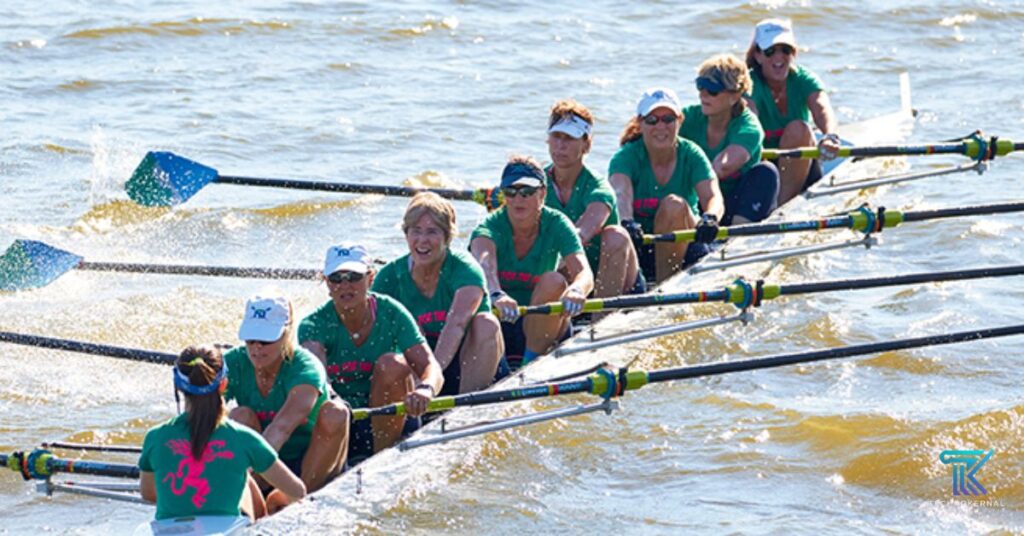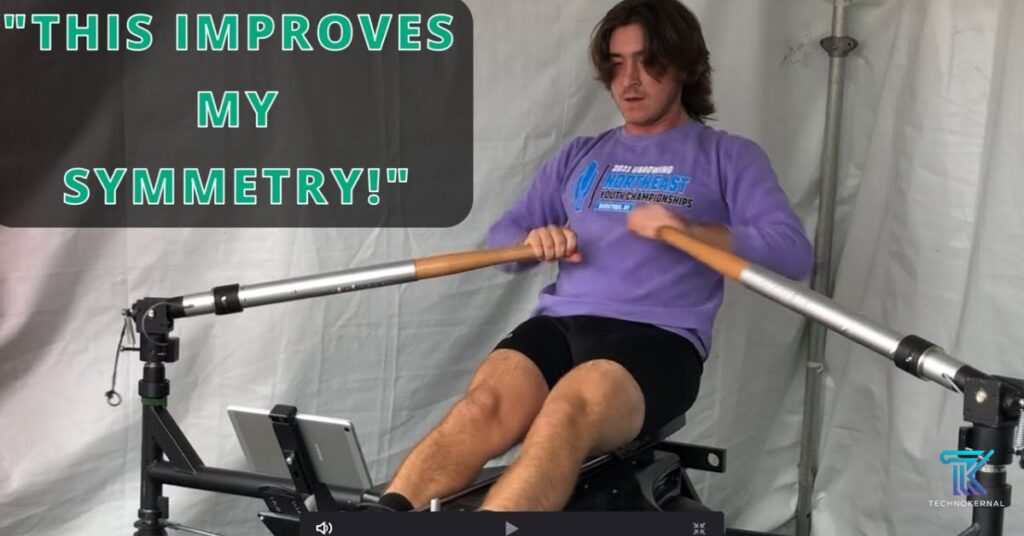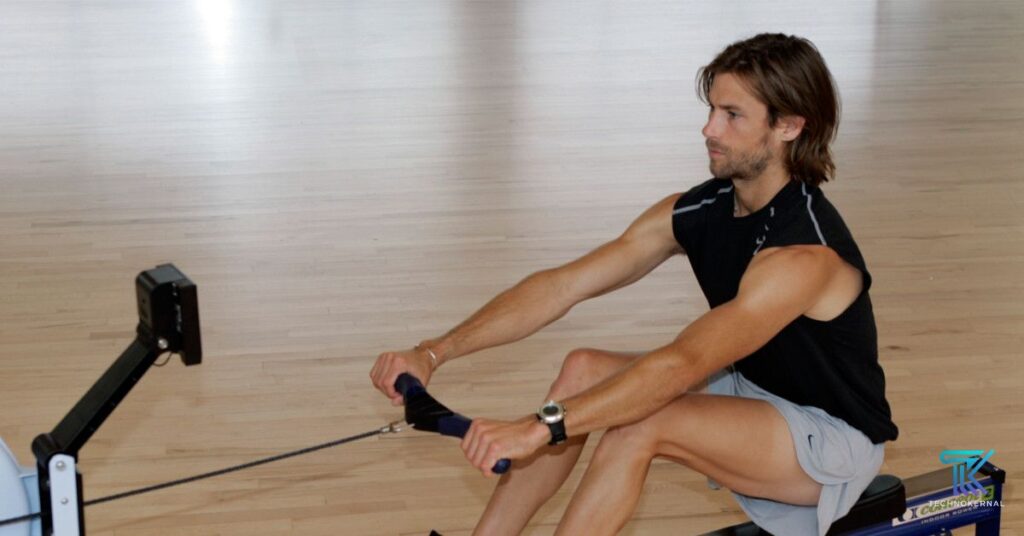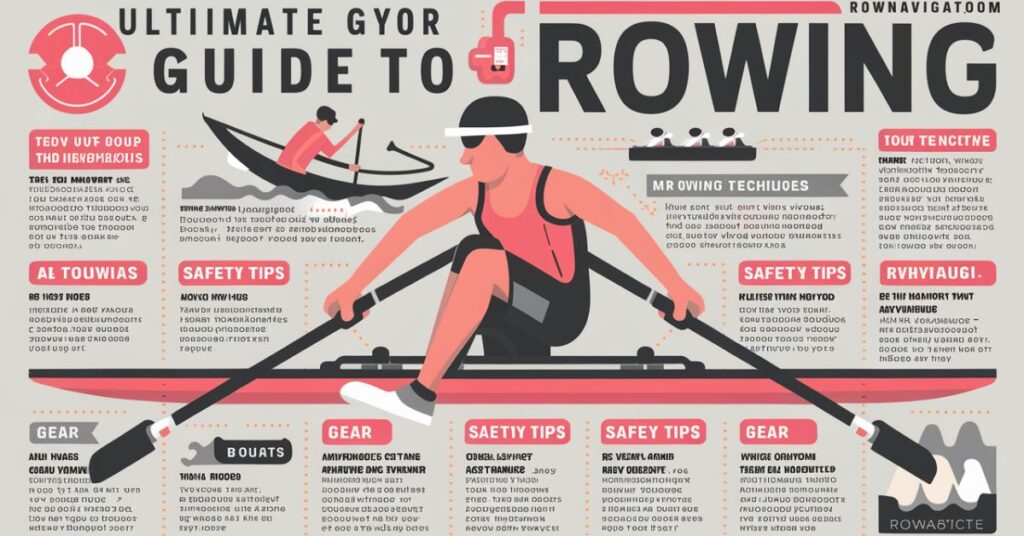The Ultimate Guide to Rowing with RowNavigator.com,” your go-to resource for mastering the art of rowing and maximizing your fitness journey. Whether you’re a novice looking to dip your oars into the world of rowing or an experienced rower seeking to enhance your skills, this comprehensive guide has you covered.
With RowNavigator.com as your trusted navigator, you’ll embark on a transformative voyage through the fundamentals of rowing technique, equipment essentials, and expert tips from seasoned rowing enthusiasts. From understanding the nuances of the rowing stroke to optimizing your performance on the ergometer.
The each section of this guide is meticulously crafted to provide you with valuable insights and practical strategies. Get ready to unlock your full potential on the water or in the gym as you embark on this exhilarating journey with RowNavigator.com by your side.
Setting Sail: Beginning Your Rowing Adventure
Begin your rowing journey confidentlyIt’s time to set sail! Starting Your Rowing Adventure Understand basics, master techniques, improve. Rowing provides full-body workout benefits.
Focus on form and posture. Explore various machine workouts. Stay consistent and progress gradually. Begin your rowing adventure now! Enjoy the journey and reap rewards.
Equipping Yourself for Success
Equipping yourself for success involves thorough preparation and readiness, ensuring you have all the necessary tools at your disposal. This means investing in quality equipment and gear, and meticulously maintaining them for optimal performance.
Planning ahead for potential challenges is key, as is staying organized and focused on your goals. It’s crucial to continuously develop your skills and knowledge, seeking guidance from experienced mentors whenever possible.
Embrace a mindset of lifelong learning and adaptation, and always strive to be fully prepared for the journey ahead, setting yourself up for success in any endeavor.
Essential Gear: Equipping Yourself for Success
Equipping yourself for success entails acquiring essential gear tailored to your needs. This includes reliable equipment and tools that enable efficient performance and enhance productivity.
Invest in high-quality gear that aligns with your goals and activities, ensuring durability and functionality. Prioritize items that provide comfort, safety, and convenience, empowering you to tackle challenges with confidence.
By carefully selecting and maintaining your essential gear, you set yourself up for success in every endeavor, maximizing your potential for achievement and growth.
Mastering Rowing Techniques
- Mastering rowing techniques requires dedication and practice.
- Start by understanding the basics: the catch, drive, finish, and recovery.
- Focus on maintaining proper form throughout each stroke.
- Pay attention to your posture and body alignment to prevent injuries.
- Use the rowing machine monitor metrics to track your progress.
- Experiment with different stroke rates and intensities to improve your skills.
- Seek guidance from experienced rowers or trainers for valuable tips and feedback.
- Consistency and patience are key to mastering rowing techniques effectively.
Technique Talk: Mastering the Stroke with RowNavigator.com
In mastering the stroke, precision is paramount. Understanding the nuances of technique can significantly enhance your rowing experience. With RowNavigator.com, you gain access to expert guidance on perfecting each aspect of the stroke.
From the catch to the finish, every movement is dissected and explained in detail. Whether you’re a novice or seasoned rower, refining your technique is essential for optimal performance and injury prevention.
With our comprehensive resources and insights, you’ll elevate your skills and maximize your potential on the water.
Training Methods and Locations
The diverse training methods and locations for your rowing journey. Explore indoor and outdoor settings, including gyms, lakes, and rivers.
From endurance-focused sessions to high-intensity interval training, tailor your workouts to your goals. With varied environments and techniques, you’ll stay engaged and motivated on your path to rowing excellence.
On the Water: Practical Tips for Outdoor Rowing
The essential tips for outdoor rowing adventures. Begin by checking weather forecasts and water conditions. Equip yourself with appropriate safety gear, including life jackets and signaling devices.
Familiarize yourself with local regulations and rowing routes. Prioritize proper hydration and sun protection during longer sessions. Maintain awareness of your surroundings and potential hazards like currents and boat traffic.
By embrace the serenity of nature and the exhilaration of open waters. With these practical tips, your outdoor rowing experiences will be safe, enjoyable, and rewarding.
The Ergometer: Training Indoors with RowNavigator.com
The benefits of indoor rowing with the ergometer. Utilize this versatile training tool to improve cardiovascular health, build strength, and enhance endurance. Set personalized workout goals and track progress with ease.
Enjoy the convenience of indoor training regardless of weather conditions. With proper technique guidance and workout plans from RowNavigator.com, maximize your indoor rowing sessions for optimal fitness results.
Whether you’re a beginner or an experienced rower, the ergometer offers a convenient and effective way to achieve your fitness goals from the comfort of your home or gym.
Engaging with the Rowing Community
Engaging with the rowing community offers numerous benefits for enthusiasts of all levels. Connect with like-minded individuals who share your passion for rowing, whether it’s through local clubs, online forums, or social media groups.

Share experiences, learn from others, and stay motivated on your rowing journey. Participate in rowing events, regattas, and challenges to challenge yourself and bond with fellow rowers. By actively engaging with the rowing community.
you’ll expand your knowledge, improve your skills, and foster meaningful connections that enhance your overall rowing experience. Embrace the camaraderie and support that comes with being part of a vibrant and inclusive rowing community.
Navigating the Rowing Community: Clubs, Regattas, and More
- Joining a rowing club provides access to coaching, equipment, and camaraderie.
- Participate in regattas to test your skills and compete with rowers from different clubs.
- Connect with experienced rowers to learn new techniques and training methods.
- Explore online forums and social media groups dedicated to rowing for tips and advice.
- Attend workshops, seminars, and events hosted by rowing organizations to expand your knowledge.
- Volunteer at regattas and community events to give back to the rowing community and build connections.
- Stay informed about local rowing activities and initiatives to stay engaged and involved.
Fitness and Nutrition for Rowers
Ensuring optimal fitness and nutrition is crucial for rowers to enhance performance and prevent injuries.
- Focus on a balanced diet rich in lean proteins, complex carbohydrates, and healthy fats to fuel workouts and aid in muscle recovery.
- Incorporate strength training to build core stability and power, complementing rowing sessions.
- Prioritize cardiovascular exercises to improve endurance and stamina on the water.
- Stay hydrated before, during, and after rowing sessions to maintain peak performance and prevent dehydration.
- Consult with a nutritionist or fitness coach to create a personalized plan tailored to your specific needs and goals.
Mental Conditioning
Mental conditioning is crucial for rowers to excel in their sport. By incorporating visualization techniques, athletes can mentally rehearse races and perfect their strokes, boosting confidence and reducing anxiety.
Mindfulness and relaxation exercises help manage stress, ensuring a clear mind during intense training sessions. Setting realistic goals and fostering a positive mindset keeps rowers motivated and resilient.
Strategies for mental toughness help overcome setbacks, while daily mental conditioning routines enhance overall performance on the water. Embracing mental conditioning is essential for rowers to achieve their full potential and succeed in their endeavors.
Injury Prevention and Recovery
| Category | Tips for Injury Prevention and Recovery |
| Warm-up and Stretching | Always warm up before rowing to prepare muscles and joints. Incorporate dynamic stretches to increase flexibility and blood flow. |
| Proper Technique | Focus on maintaining correct rowing form to reduce strain on muscles and joints. Engage core muscles and avoid overreaching during the stroke. |
| Gradual Progression | Gradually increase intensity and duration of workouts to prevent overuse injuries. Avoid sudden spikes in training volume. |
| Rest and Recovery | Allow for adequate rest between rowing sessions to promote muscle recovery. Incorporate active recovery techniques such as foam rolling and light stretching. |
| Cross-training | Incorporate cross-training activities to prevent overuse injuries and balance muscle development. Include activities like swimming, cycling, or yoga. |
| Listen to Your Body | Pay attention to any signs of discomfort or pain during rowing. Address minor injuries promptly to prevent them from becoming more severe. |
| Nutrition and Hydration | Maintain a balanced diet rich in nutrients to support muscle recovery and overall health. Stay hydrated before, during, and after rowing sessions. |
| Flexibility and Mobility | Incorporate regular flexibility and mobility exercises to improve joint range of motion and prevent stiffness. Focus on areas prone to tightness, such as the hips, shoulders, and lower back. |
Advancing Your Skills
Advancing your rowing skills requires dedication, practice, and a willingness to push beyond your comfort zone. Start by focusing on mastering the fundamentals of rowing technique, such as the catch, drive, finish, and recovery.

Regularly review your form and seek feedback from experienced rowers or coaches to identify areas for improvement. The incorporate structured training programs that include a variety of workouts to build endurance, strength, and power.
Experiment with different training intensities, stroke rates, and distances to challenge yourself and develop a deeper understanding of your capabilities. Set realistic goals and track your progress over time to stay motivated and measure your success.
From stay engaged with the rowing community by participating in club events, regattas, and workshops to learn from others and share experiences. With perseverance and determination, you can continue to advance your rowing skills and achieve new levels of performance.
Competitive Insights
| Aspect | Description |
| Training Intensity | Varies based on competition level and individual goals. |
| Technique | Focus on perfecting stroke mechanics, timing, and efficiency. |
| Equipment | High-quality rowing machines, oars, and appropriate clothing. |
| Nutrition | Balanced diet rich in carbohydrates, protein, and healthy fats. |
| Recovery | Adequate rest, hydration, and recovery practices such as stretching and foam rolling. |
| Mental Preparation | Visualization, goal-setting, and stress management techniques. |
| Competition Strategies | Tailored race plans, understanding opponents, and adapting to changing race conditions. |
| Team Dynamics | Effective communication, trust, and cooperation among team members. |
| Performance Analysis | Reviewing race data, identifying areas for improvement, and adjusting training accordingly. |
| Injury Prevention | Regular injury assessments, proper warm-up and cool-down routines, and cross-training to prevent overuse injuries. |
This table provides insights into various aspects of competitive rowing, including training, technique, equipment, nutrition, recovery, mental preparation, competition strategies,
The team dynamics, performance analysis, and injury prevention. Each aspect plays a crucial role in optimizing performance and achieving success in competitive rowing.
Supplementary Training
Supplementary training for rowers encompasses a range of exercises and activities designed to enhance overall performance and prevent injury. This includes strength training to build muscle power and endurance.
The flexibility exercises to improve range of motion and reduce the risk of injury, and core stability workouts to enhance balance and posture. Additionally, cross-training activities such as cycling,

By swimming, and yoga can provide a well-rounded fitness regimen while giving rowers a break from the repetitive motion of rowing. Integrating supplementary training into a rowing regimen can lead to improved performance, resilience, and overall athletic development.
READ THIS BLOG : UNVEILING THE WONDERS OF WDROYO TECHNOLOGY
Cross-Training: Complementary Exercises for Rowers
Cross-training offers rowers a diverse range of exercises to complement their training regimen. Activities like cycling, swimming, and yoga target different muscle groups, enhancing overall strength, flexibility, and endurance.
By incorporating cross-training into their routine, rowers can prevent overuse injuries, improve cardiovascular fitness, and break up the monotony of rowing. This approach not only boosts physical performance but also promotes mental freshness and motivation.
Including cross-training in a rowing program helps athletes achieve a well-rounded fitness level, supporting their long-term success on and off the water.
Tracking Progress
Tracking progress is essential for rowers to monitor their performance and set achievable goals. Utilizing tools such as training logs, workout journals, or fitness apps allows athletes to record key metrics like distance covered, stroke rate, split times, and heart rate.
By regularly tracking progress, rowers can identify strengths and weaknesses, measure improvements over time, and adjust their training accordingly. This data-driven approach enables athletes to stay motivated, maintain consistency,
The optimize their training strategies for better results. Tracking progress provides valuable insights into overall fitness levels and helps rowers stay accountable to their training plans.
Structured Training Programs
Structured training programs provide rowers with a systematic approach to improving their skills and performance. These programs typically include a variety of workouts tailored to different aspects of rowing, such as endurance, strength, technique, and speed.
They are designed by experienced coaches or trainers and often follow periodization principles, dividing training into specific phases to target different training goals throughout the season. Structured training programs help rowers stay focused, motivated.
The organized in their training regimen, ensuring that they progress steadily and avoid plateaus. Additionally, they provide a clear roadmap for achieving long-term success in rowing by gradually building fitness, skills, and race readiness.
Progression Pathways
- Progression pathways in rowing outline the steps and milestones for athletes to advance in their skill and performance levels.
- They typically start with foundational skills and gradually progress to more advanced techniques and training methods.
- Progression pathways often include benchmarks for achieving specific goals, such as improving stroke efficiency, increasing power output, or competing at higher levels.
- Coaches and trainers use progression pathways to structure training programs and track athletes’ development over time.
- These pathways help athletes set realistic goals, measure their progress, and stay motivated on their journey to becoming proficient rowers.
From Novice to Expert: Your Growth Pathway
From novice to expert, your growth pathway in rowing entails gradual skill development and performance enhancement. Starting with basic techniques, you progress through training milestones.
The mastering advanced skills, and achieving competitive prowess. This pathway guides your journey from beginner to proficient rower, marking your progress along the way.
Balancing Sport and Life
| Aspect | Description |
| Time Management | Allocate specific time slots for training, competitions, and personal commitments. |
| Prioritization | Identify priorities in both sports and personal life to ensure essential tasks are accomplished. |
| Flexibility | Remain adaptable to accommodate unforeseen events or changes in schedule. |
| Rest and Recovery | Incorporate sufficient rest periods to avoid burnout and maintain overall well-being. |
| Communication | Maintain open communication with coaches, family, and friends to manage expectations effectively. |
Community Engagement
Community engagement involves actively participating in various social activities, events, and initiatives within your local or online communities. It entails building connections, fostering relationships, and contributing positively to the collective well-being.
This involvement can take many forms, such as volunteering, attending community meetings, organizing events, or participating in online forums and discussions. By engaging with your community, you not only strengthen.
The bonds and networks but also gain valuable insights, support, and a sense of belonging. Ultimately, community engagement enriches both individuals and the communities they belong to, creating a more vibrant and connected society.
READ THIS BLOG : EXPLORING GEÖE: REVOLUTIONIZING SUSTAINABILITY WITH INNOVATIVE SOLUTIONS
Embracing Technology
- Embracing technology involves adopting and utilizing digital tools, devices, and platforms to enhance various aspects of life.
- It includes integrating technology into daily routines, work processes, and communication methods for increased efficiency and productivity.
- Embracing technology also entails staying informed about the latest advancements and trends in technology to adapt and leverage them effectively.
- It involves embracing a mindset of curiosity, openness, and willingness to explore and learn new technological innovations.
- By embracing technology, individuals can streamline tasks, access information more readily, connect with others globally, and improve overall quality of life.
Leveraging Resources
Leveraging resources involves maximizing the use of available assets, whether they are financial, human, or technological, to achieve desired outcomes. It encompasses strategic planning and allocation of resources to optimize efficiency and effectiveness in various endeavors.
By identifying and harnessing the strengths of each resource, individuals and organizations can capitalize on opportunities, mitigate risks, and achieve their goals more effectively. Additionally, leveraging resources involves fostering collaborations and partnerships to access
The expertise, networks, and capabilities that complement existing resources. Ultimately, it empowers individuals and organizations to achieve greater success and impact in their endeavors.
Resources and Community Support
- Financial Assistance: Grants, funding opportunities, sponsorships.
- Physical Facilities: Access to rowing centers, training facilities.
- Equipment: Availability of rowing machines, boats, oars.
- Technology: Use of performance tracking apps, video analysis tools.
- Mentorship Programs: Guidance from experienced rowers or coaches.
- Educational Workshops: Training sessions on rowing techniques, fitness, and nutrition.
- Networking Events: Opportunities to connect with other rowers, coaches, and experts.
- Online Communities: Forums, social media groups for sharing tips, experiences.
FAQs
What is rowing?
Rowing is a sport where individuals or teams propel a boat through water using oars.
How do I get started with rowing?
Start by finding a local rowing club or gym with rowing machines. Join a beginner’s class or seek guidance from experienced rowers.
What are the health benefits of rowing?
Rowing provides a full-body workout, improves cardiovascular health, strengthens muscles, and enhances endurance.
Do I need any special equipment to start rowing?
Basic equipment includes a rowing machine (ergometer), comfortable workout clothing, and water bottle. Outdoor rowing may require access to boats and oars.
Is rowing suitable for beginners?
Yes, rowing is suitable for beginners of all ages and fitness levels. Start with proper instruction and gradually increase intensity.
How can I prevent injuries while rowing?
Practice proper technique, warm up before rowing, listen to your body, and incorporate cross-training and stretching into your routine.
Are there competitive opportunities in rowing?
Yes, rowing offers various competitive opportunities, including regattas, races, and competitions at local, national, and international levels.
Conclusion
In conclusion, embracing rowing as a fitness endeavor offers a multitude of benefits for individuals seeking a full-body workout and improved cardiovascular health. With proper training, technique, and access to resources,
The rowers can progress from novice to expert, participating in competitive events and engaging with a supportive community. Whether indoors on a rowing machine or outdoors on the water, rowing provides a versatile and engaging form of exercise suitable for people of all ages and fitness levels.
By incorporating rowing into their fitness routines, individuals can achieve their health and wellness goals while enjoying the camaraderie of the rowing community.

Robert with 4 years of tech experience, brings expertise to our website, driving innovation and technological advancements.







